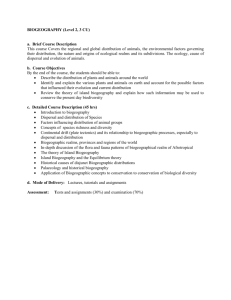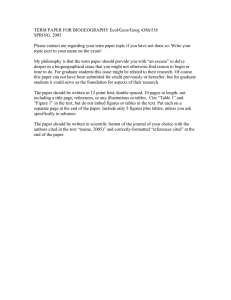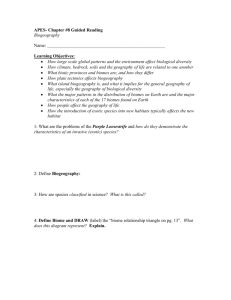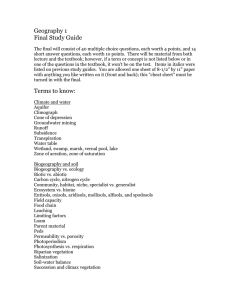REQUEST FOR A NEW COURSE Proposal # University of Central Oklahoma
advertisement
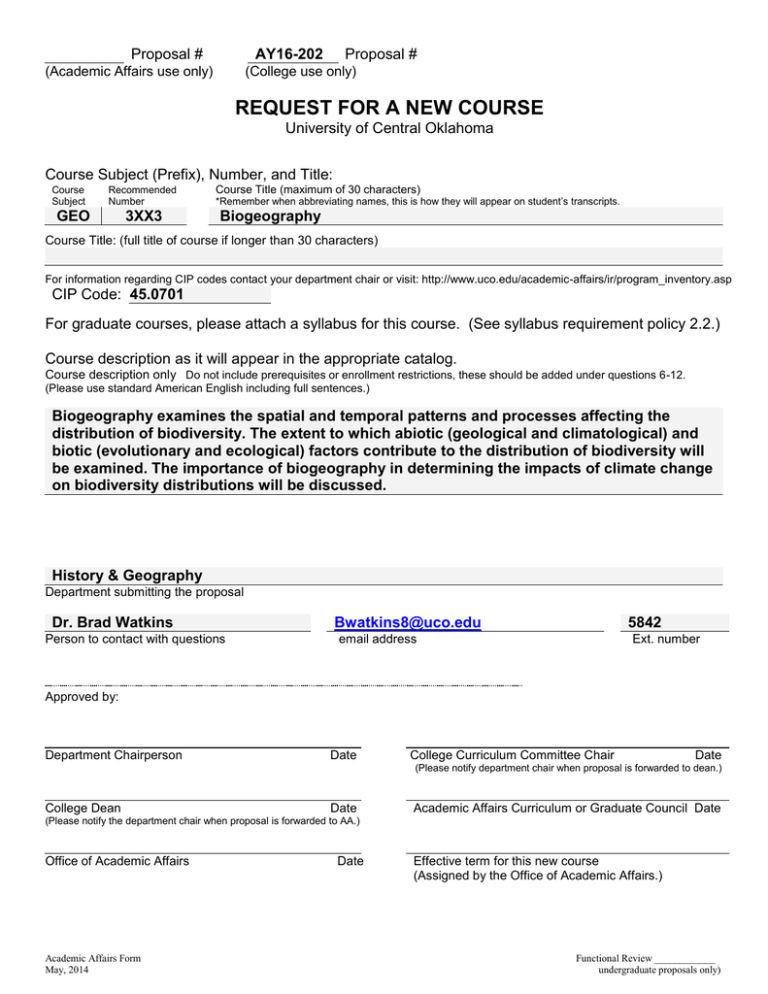
Proposal # AY16-202 (Academic Affairs use only) Proposal # (College use only) REQUEST FOR A NEW COURSE University of Central Oklahoma Course Subject (Prefix), Number, and Title: Course Subject Recommended Number GEO 3XX3 Course Title (maximum of 30 characters) *Remember when abbreviating names, this is how they will appear on student’s transcripts. Biogeography Course Title: (full title of course if longer than 30 characters) For information regarding CIP codes contact your department chair or visit: http://www.uco.edu/academic-affairs/ir/program_inventory.asp CIP Code: 45.0701 For graduate courses, please attach a syllabus for this course. (See syllabus requirement policy 2.2.) Course description as it will appear in the appropriate catalog. Course description only Do not include prerequisites or enrollment restrictions, these should be added under questions 6-12. (Please use standard American English including full sentences.) Biogeography examines the spatial and temporal patterns and processes affecting the distribution of biodiversity. The extent to which abiotic (geological and climatological) and biotic (evolutionary and ecological) factors contribute to the distribution of biodiversity will be examined. The importance of biogeography in determining the impacts of climate change on biodiversity distributions will be discussed. History & Geography Department submitting the proposal Dr. Brad Watkins Person to contact with questions Bwatkins8@uco.edu 5842 email address Ext. number Approved by: Department Chairperson Date College Curriculum Committee Chair Date (Please notify department chair when proposal is forwarded to dean.) College Dean Date Academic Affairs Curriculum or Graduate Council Date (Please notify the department chair when proposal is forwarded to AA.) Office of Academic Affairs Academic Affairs Form May, 2014 Date Effective term for this new course (Assigned by the Office of Academic Affairs.) Functional Review ____________ undergraduate proposals only) 1. Does this course have an undergraduate / graduate counterpart? Yes X No 2. Is this proposal part of a larger submission package including a program change? X Yes No 3. Does this new course affect a teacher preparation program? (All courses required for any teacher preparation program must have approval from the Council on Teacher Education (CTE) before approval from AACC or Graduate Council.) Yes X No If yes, send copy of proposal to the Director of Teacher Education, Dr. Bryan Duke. CTE Approval (Stamp or initial)______________________ 4. Has this course been previously taught as a common course (4910 seminar, 4960 institute, etc.)? Yes X No If yes, when was the most recent offering? 5. Does this course affect majors or minors outside the department? Yes X No If yes, provide name(s) of department chair(s) contacted, dates, and results of discussion. 6. Prerequisite courses: Example 1: MATH 1213 and (MATH 2165 or MATH 2185) and CHEM 1213 Example 3: 8 hours of biology including BIO 1404 Example 2: (ACCT 2113 and 2213) and (MGMT 3013 or ISOM 3613) None 7. Co-requisite(s): Which of the above prerequisite courses, if any, may be taken in the same semester as the proposed new course? None 8. Concurrent enrollment: None Courses that must be taken the same semester. Example: lab courses. 9. Will this course have enrollment restrictions? X Yes No If No, go to question 13. 10. Specify which major(s) may or may not take this course. Specifying a major, excludes all other majors from enrolling. Check one: May May not Major Code: 11. Which of the following student classification(s) may enroll in this course? Graduate Graduate Post Baccalaureate * Senior Junior Sophomore Freshman Check all that apply: (2) 19 + hours (1) 0-18 hours X X * Graduate level courses are not open to Post Baccalaureate students. 12. Check or list other restrictions for this course. Admission to Graduate Programs Admission to Nursing Program Admission to Teacher Education Other Academic Affairs Form May, 2014 Functional Review ____________ undergraduate proposals only) 13. Course objectives: Objectives should be observable, measurable and include scholarly or creative activities to meet the course level characteristics. Course objectives should also be in line with the course description. (Please refer to instructional objectives documents at: http://www.uco.edu/academic-affairs/faculty-staff/aacc.asp#FAQ/Helpful%20Hints.) 1) Relate biogeographic distributions of plants and animals to biotic and abiotic drivers across spatial and temporal scales. 2) Explain the historical background of biogeography. 3) Recognize the spatial and temporal patterns and processes that determine species distributions. 4) Discuss the importance of biogeography in determining the impacts of climate change. 5) Identify contemporary biogeographic research and discuss its relevancy to understanding the field of biogeography. 6) Interpret and apply biogeographic knowledge to an individual research project. Course Detail Information: 14. Contact Hours (per week) 3 Lecture hours (in class) Lab hours (also studios) Other (outside activities) 15. Repeatable course. 1 Number of times this course can be taken for credit. 16. Schedule type: (select one only) L Activity P.E. (A) Lab only (B) Lecture/Lab (C) Lecture only (L) Recitation/Lab (R) Student Teaching (STU) Studio Art/Design (XSU) 17. List existing course(s) for which this course will be a prerequisite. an existing course will likely cause enrollment problems. Adding a “new course” as a prerequisite to (Please submit a prerequisite change form for each course for which this course will serve as a prerequisite.) None 18. What resources, technology or equipment must be acquired to teach this course? List items, which must be purchased and estimated cost. (Be specific, e.g., technology software, equipment, computer lab; etc.) No additional resources are required to teach this course. Current Physical Geography with Lab supplies are sufficient. Academic Affairs Form May, 2014 Functional Review ____________ undergraduate proposals only) 19. The UCO Library has the required library resources available for this new course? No If yes, provide names of Librarian/Faculty Liaisons contacted, dates, and results of discussion. X Yes Shay Beezley was contacted on 2-1-16. Beezley replied with detailed email listing numerous library resources. There are sufficient resources for this course. If no, what additional library resources must be acquired for this new course? List items which must be purchased and estimated cost. (Be specific, e.g., books, magazines, journals, etc.) 20. Names of current faculty qualified to teach this course. Dr. Shannon Hall; Dr. Brad Watkins 21. Additional faculty (adjunct or full-time) required and specific competencies required to teach this course: No additional faculty are required to teach this course. 22. How will this course be staffed and equipped? Identify the additional costs associated with this new course. If no costs, explain why not. Current faculty will teach this course as part of the regular course rotation. The department of History & Geography has reduced the number of lower division hours to enable faculty to offer this course. 23. Identify the source(s) of funds for any additional costs for the new course. i.e. internal reallocations, special fees from students, etc. If you plan to propose special fees be assessed for this course, be aware there is a separate approval process for special fees. No additional costs will be required. 24. Projected enrollment for two academic years following approval of new course: Semester Fall Spring Summer 2017 15 2018 25 25. Using State Regents’ definition of liberal arts and sciences (quoted below), characterize the course as follows: X Non-liberal arts and sciences Liberal arts and sciences “The liberal arts and sciences are defined as those traditional fields of study in the humanities; social and behavioral sciences; communications; natural and life sciences, mathematics; and the history, literature, and theory of fine arts (music, art, drama, dance). Courses in these fields whose primary purpose is directed toward specific occupational or professional objectives, or courses in the arts which rely substantially on studio or performance work are not considered to be liberal arts and sciences for the purpose of this policy. Courses required for the General Educational Program are not necessarily synonymous or mutually exclusive with the liberal arts and sciences.” State Regents Policy and Procedures. Chapter 2, Section 5, “Degree Requirements” part 1, (2). P. II-2-86 Academic Affairs Form May, 2014 Functional Review ____________ undergraduate proposals only) 26. Please provide a concise, yet comprehensive, statement that explains the reasons for requesting the new course. Include documentation or assessment information supporting the specific request (if possible). Indicate the expected source of student enrollment (majors, minors, programs etc.) Biogeography will strengthen the physical geography component of the Geography B.A. program. Two of the three faculty have research specializations in biogeography and the faculty regularly conduct field trips that involve biogeography related topics in other courses (Physical Geography with Lab and Advanced GIS: Environmental). This course will offer advanced instruction for students. Dr. Patti Loughlin (History & Geography Chair) supports the development of the course. The course will serve students from Geography and Biology. 27 Which of the six transformative learning tenets does this course incorporate? (check all that apply or only those that apply) This question was a directive from the Provost and is used for informational purposes. Discipline Knowledge Leadership Research, Scholarly and Creative Activities Service Learning and Civic Engagement Global and Cultural Competencies Health and Wellness Academic Affairs Form May, 2014 X X X Functional Review ____________ undergraduate proposals only) 28. Clearly explain how the characteristics of this course meet or exceed those outlined in Course Level Characteristics. (Copy and paste table from “Course Level Characteristics” document for the appropriate course level of proposed course. Document may be found on: http://www.uco.edu/academic-affairs/files/aacc/forms/CLC%20table4_07.pdf. 3000 LEVEL COURSES Course Level Characteristics 1. It is assumed that students in these courses have completed sufficient course work to have attained junior standing. 2. These courses should be offered at a level of instruction that assumes a foundation of study in the discipline, which most often would have been gained through one or more introductory courses. 3. Students in these courses should be required to undertake a scholarly activity in addition to classroom instruction, such as a written research project, library assignment, juried performance, or creative work. 4. These courses should be more specialized in content than lower division courses. Academic Affairs Form May, 2014 Please describe how this course meets this requirement. Junior standing is required. Students are presumed to have taken 1000 and 2000 level courses. Students will be required to complete a research paper that incorporates biogeographic concepts, and will help students gain a stronger comprehension of biogeography. Students will be required to use scholarly research articles, and current biogeographic data when preparing their papers. Other geographic resources that students may use include climate and/or geologic data, historic land survey data, remote sensing, and GIS. Biogeography is only covered briefly in one chapter and one lecture of the lower division courses. This course will devote an entire semester to the field and study of biogeography, so the level of specialization covered in the course content will far surpass the brief mentions of the subject in the lower level classes. Students will be required to read and discuss two biogeography texts and several scholarly research articles during the course, in addition to the required term paper on the subject. Functional Review ____________ undergraduate proposals only)
